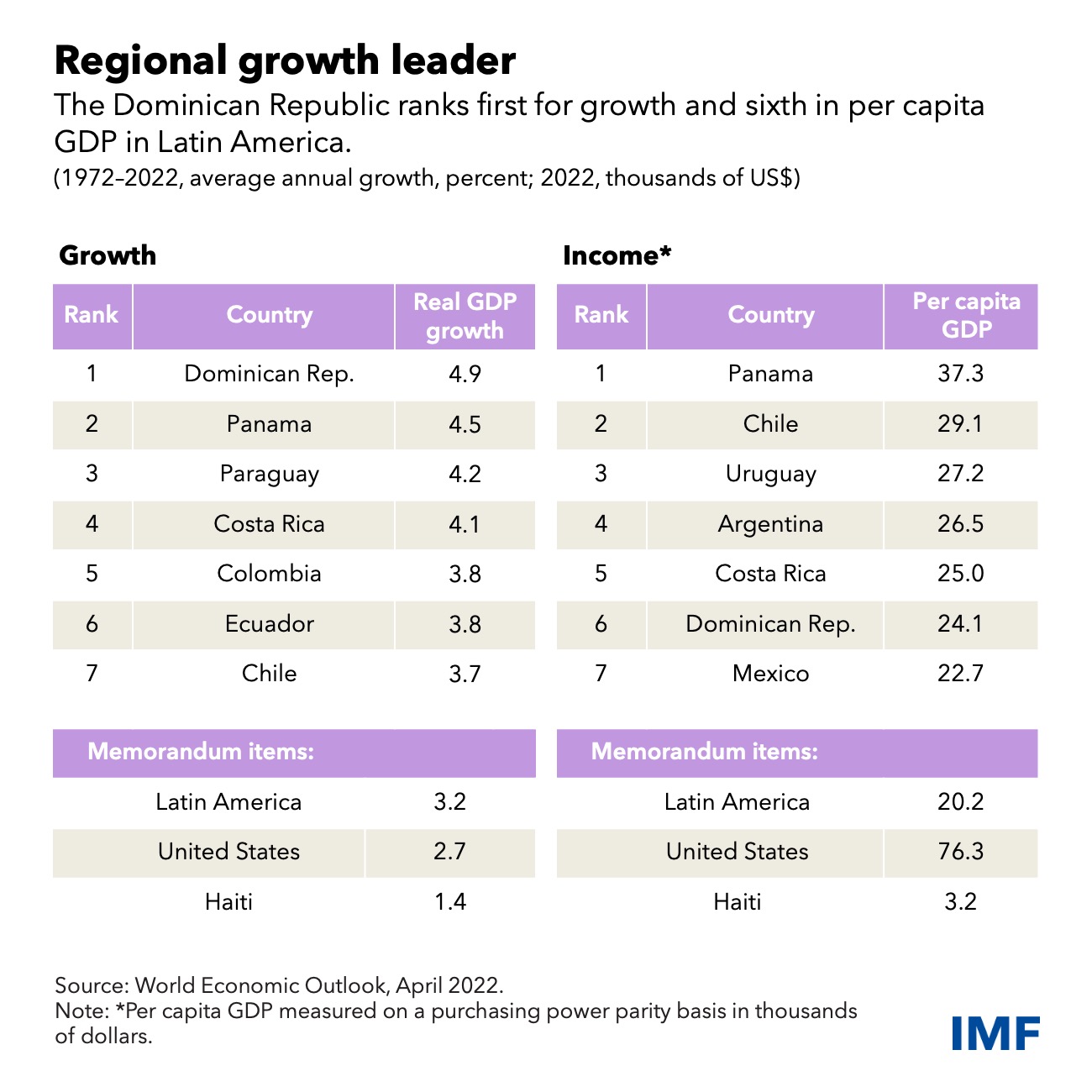Dominican Republic's Income Convergence Signals Path to Advanced Economy Status in Coming Decades
August 3, 2023
The country leads Latin America in rapidly narrowing the income gap with the United States
Despite being one of Latin America’s poorest countries in the mid-1960s, the Dominican Republic has made remarkable progress in terms of income convergence.
Income convergence is typically measured by comparing the per capita income of a country to that of a more prosperous nation, often the United States. For the Dominican Republic, this ratio reached 32 percent in 2022, indicating that the country’s standard of living is approximately one-third that of the United States. This stands in contrast to Latin America as a whole, where the average standard of living is around one-quarter that of the United States.
With the right policies, the country has the potential to become an advanced economy in the next 40 years.
Converging at “blue” speed
What is remarkable about the Dominican Republic’s progress is not just the level of convergence but also its speed compared to other countries in the region. By examining the average convergence velocity, or the rate of change in income convergence per decade, it is evident that the Dominican Republic has exhibited the highest average convergence velocity, or “blue shift,” in Latin America over the past 50 years. Panama and Chile have achieved equally meaningful but still lower positive convergence velocities, while the majority of countries in the region have experienced either very low (“green shift”) or negative (“red shift”) convergence velocities.
Despite encountering challenges, such as the debt crisis of the 1980s, the Dominican Republic’s economy has been converging at a faster rate. The convergence velocity has increased from an average of 3 percentage points per decade over the last 50 years to almost 8 percentage points per decade more recently. This remarkable performance can be attributed to several factors, including implementation of sound policies, particularly by the central bank, improvements in policy framework, a more diversified export base, and the economy’s structural flexibility to changing global conditions.
From agricultural roots to economic dynamism
Over the last half century, the Dominican Republic has transformed, first from a primarily agricultural-based to a more manufacturing-oriented economy supported by the growth of free trade zones, and subsequently to a services-driven economy bolstered by the exploitation of the country’s tourism potential and the expansion of the financial system.
Today, the country maintains a balanced mix of industries and sectors, including agriculture, manufacturing, and services, and boasts the sixth highest per capital GDP in Latin America when accounting for purchasing power, surpassing regional giants like Brazil and Mexico.
Such dynamism has played a crucial role in reducing poverty by two-thirds over the past three decades and reducing inequality, with the Gini coefficient falling by a quarter, indicating a continued positive trend towards more equal distribution of income.
This progress has impacted the average Dominican family, whose purchasing power has increased fourfold in the last 50 years, enabling them to enjoy a better quality of life and greater economic opportunities.
The sound policies that led to Dominican Republic’s high growth required timely policy adjustments, often in response to shocks and changing conditions. In this regard, IMF-supported programs through various crises have played an important role.
Prioritizing reforms for sustained growth
Looking ahead, there are reasons to believe that the Dominican Republic can sustain its high growth. IMF staff estimates potential growth at 5 percent per year, similar to the average of the last 50 years.
To fuel higher potential growth, the Dominican Republic can prioritize key structural reforms. This includes enhancing the quality of education to boost workforce productivity; completing electricity sector reform to improve distribution, eliminate blackouts, and enhance renewable energy adoption; strengthening the resilience of the tourism and agricultural sectors against natural disasters and climate change; addressing labor market informality for better job quality; further improving the business climate to achieve investment grade status to attract higher levels of investment; and embracing technology and fostering innovation.
While risks lie ahead—particularly those associated with climate change—continued implementation of reforms aimed at fostering productivity can help maintain high growth rates, pave the way for a prosperous future for its people, and eventually transform the Dominican Republic into an advanced economy by approximately 2060. Such progress would represent a significant “blue shift” in the country’s history and serve as undeniable evidence of its ongoing development.
****
Frank Fuentes is Advisor to the IMF Executive Director representing the Dominican Republic.
Emilio Fernandez is Mission Chief for the Dominican Republic and Deputy Division Chief in the IMF Western Hemisphere Department.
Alejandro Santos is Advisor in the IMF Western Hemisphere Department.










